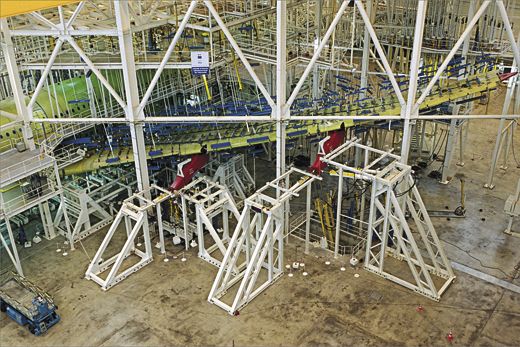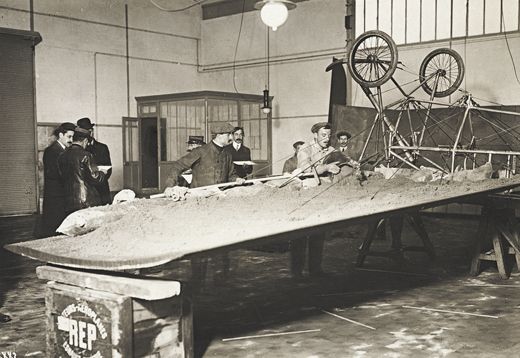Then & Now: Under Stress
Then & Now: Under Stress
/https://tf-cmsv2-smithsonianmag-media.s3.amazonaws.com/filer/Arch_Wing_Then_Main_AM09.jpg)
When it came to testing the integrity of aircraft wings, early builders didn't have many choices. On fabric and wood wings, they piled sand—loosed or bagged—to see how much weight could be borne. For sturdier wings, they had workers stand on the wing to determine stress limits.
"It's all they could do. There was a lot of guesswork then," says Howard Wolko, a retired special assistant at the National Air and Space Museum and an authority on the history of aircraft structure. "They basically tested it until it broke."
It wasn't until 1920, when Donald Douglas set up his own aircraft company, that wing stress tests began to advance. Douglas, one of the first designers with an aeronautical engineering degree from the Massachusetts Institute of Technology, brought a key tool to the process: mathematics. "That's when reasonable structural analysis techniques began to be used," says John Anderson, curator of aerodynamics at the Museum. "Douglas carried with him from MIT modern techniques for stress calculation, all done on a slide rule."
With the invention of the strain gauge in 1938, a wing's structural integrity could be verified without having to flex the entire wing. Strain gauge measurements were then adopted for use in U.S. military aircraft development during World War II.
Strain gauges are still used today to verify the accuracy of computer analytical models that drive the design and manufacture of a wing. Boeing, which is building the 787 Dreamliner, uses computers to analyze 9,000 actuator-induced stress points on the aircraft, including 2,000 on each wing.
"As you push up on a wing, our analysis says it ought to deflect a certain amount, so we measure [with strain gauges] the amount it actually deflects," says Mark Jenks, vice president of development for the 787. "The basis of [federal] certification is analysis supported by test."
Last November, Boeing tested to destruction a full-scale composite wing box, a beam that carries the wing to the fuselage and that supports the control surfaces, engines, and landing gear. To meet federal certification, the wings must withstand loads up to 1.5 times what the jet could expect to see in its roughly 20-year lifetime. The 50-foot-long wing box, half the span of an actual 787 wing, withstood the load.
Boeing will do two static tests to measure wing stress before the Dreamliner's first test flight this year; structural fatigue tests also are planned to begin. Though Boeing has a long history testing metal-wing aircraft like the 777 and earlier models, with the all-composite 787, says Jenks, "we're lower on the learning curve" so more testing is in order.
Paul Hoversten is the Air & Space executive editor. His last feature was about Amelia Earhart ("An American Obsession," June/July 2007).

